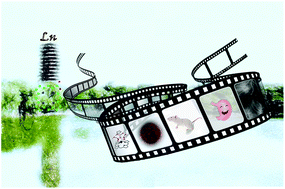Joining the journey to near infrared (NIR) imaging: the emerging role of lanthanides in the designing of molecular probes
Abstract
Near-infrared (NIR, 700–1700 nm) bioimaging has gained considerable attention in recent years owing to its high imaging resolution and increasing penetration depth of tissues. NIR emissive lanthanide(III) complexes have emerged as alluring candidates for the design of NIR molecular probes in clinical imaging and diagnosis because of their desirable temporal–spatial resolution, negligible photobleaching effect, long lifetime and low biotoxicity. In this mini-review, we summarize our efforts in the molecular design of NIR luminescent lanthanide porphyrinoids and their biological applications in bioimaging and further clinical diagnosis and treatment. Remarkably, β-fluorinated porphyrin Yb3+ probes exhibit high luminescence (5–13% quantum yields in H2O), long decay lifetimes (>100 μs) and enable in vivo fluorescence intensity imaging and time-resolved fluorescence lifetime imaging (FLIM). Finally, the main concerns and challenges for NIR emissive Ln biolabels such as the diversity of the NIR Ln3+ optical toolbox and their biocompatibility and targeting capability in biological media are discussed so as to facilitate the long-term development of lanthanide chemical biology.

- This article is part of the themed collections: Rare Earth Chemistry – In memory of Professor Xu Guangxian at his centenary, 2020 Inorganic Chemistry Frontiers Review-type Articles and Celebrating 110th Anniversary of Chemistry at Peking University


 Please wait while we load your content...
Please wait while we load your content...